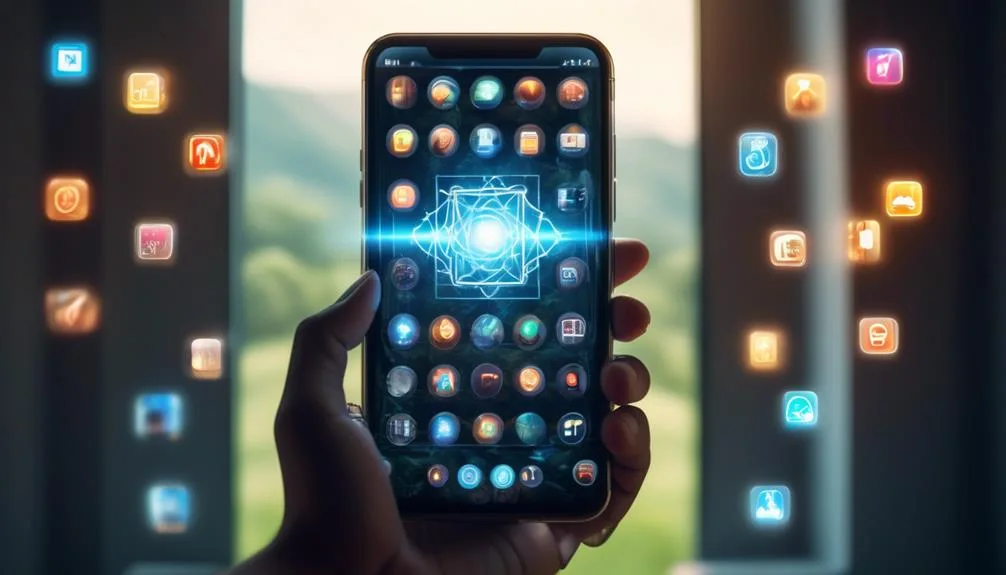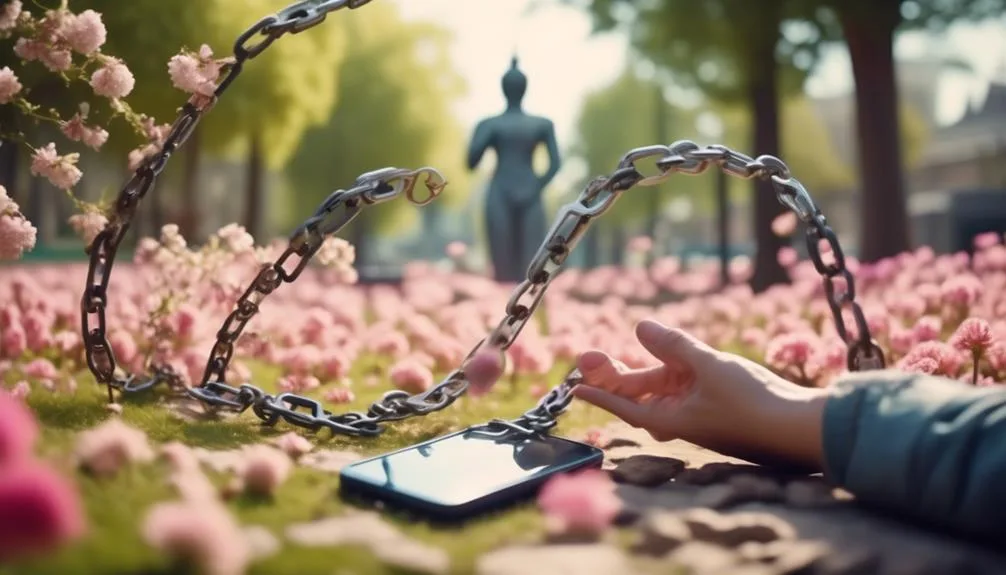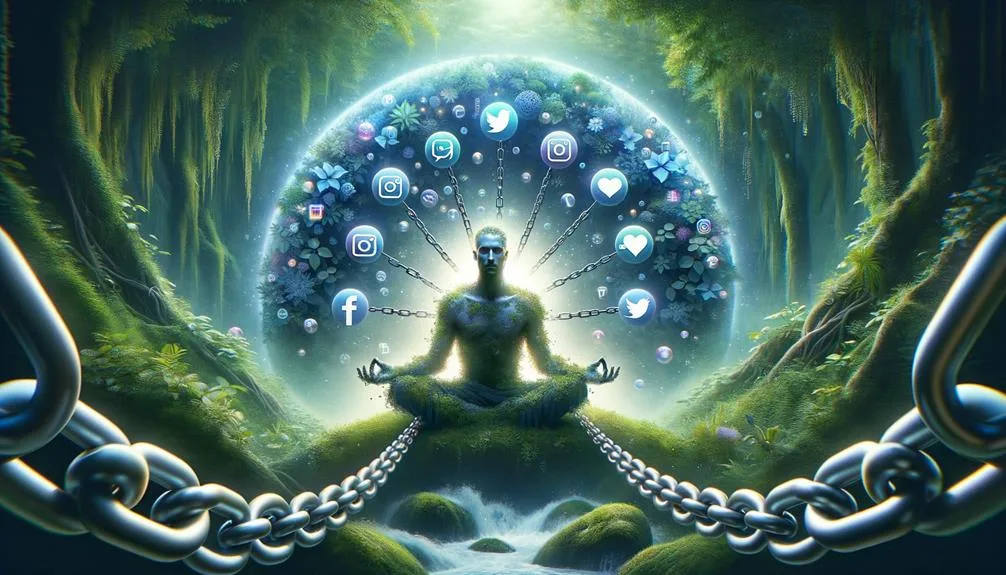As you navigate the choppy waters of your digital life, the siren song of social media constantly beckons, promising connection yet often delivering distraction and discontent.
You've likely felt the tug-of-war between wanting to stay informed and connected with those around you, and the desire to reclaim your time and attention from the grips of an algorithm.
The key to breaking free lies not in a herculean effort but in the steady application of practical steps tailored to your unique lifestyle. From setting boundaries that honor your personal and professional goals to replacing the habitual scroll with more fulfilling activities, you'll find that regaining control is within reach.
As you consider the possibility of a more balanced digital existence, remember that the journey of a thousand miles begins with a single step. Stay tuned to learn how small changes can lead to significant impact and how you can embark on this path toward digital well-being.
Key Takeaways
- Recognizing and acknowledging social media addiction is the first step towards overcoming it.
- Identifying triggering situations and emotional states that lead to excessive social media usage can help break free from the addiction.
- Understanding habitual usage patterns and setting boundaries can help regain control over social media usage.
- Establishing specific time limits, scheduling offline activities, and using app blockers can support a healthier digital life.
Understanding Social Media Addiction
Social media addiction, a modern-day quandary, often manifests as an irresistible urge to check notifications, leading to a spiral where you're constantly seeking the next digital interaction. If you're spending too much time on social media, it may disrupt your ability to perform daily tasks and negatively impact your work performance. This compulsive social media use can cause withdrawal symptoms like mood swings and depression, often driven by a fear of missing out.
It's crucial to acknowledge how these social media habits affect your mental health. To break free, you need to understand the roots of being addicted to social media and actively seek methods to reduce the temptation. Remember, recognizing the problem is the first step towards a healthier digital life.
Recognizing the Triggers

Understanding what prompts you to reach for your phone can be key to breaking the cycle of social media addiction.
You might notice you're more likely to scroll through feeds when you're feeling lonely or anxious, or that certain times of day trigger an almost automatic log-in.
Identifying Triggering Situations
Recognizing the specific situations or emotions that send you reaching for your phone can be a critical step in breaking free from the grip of social media addiction. It's about understanding when and why you're more likely to spend time on social networks.
Here's a quick guide to identifying triggering situations:
- Boredom or loneliness prompting an automatic log-in
- Stressful events leading to the comfort of scrolling
- Procrastination pushing you to check updates instead of working
- Work breaks that habitually turn into social media sessions
- Late-night urges to stay connected despite the need to sleep
Emotional States and Social Media
Amid the daily hustle, it's often our unchecked emotions that stealthily lead us to the endless scroll of social media feeds. Recognizing the emotional states that trigger your social media usage is crucial. Are you seeking comfort, connection, or maybe a distraction from stress? It's important to understand these triggers to take control of your digital life.
| Emotional State | Influence on Usage | Healthy Strategy |
|---|---|---|
| Boredom | Increased scrolling | Plan offline activities |
| Loneliness | Seeking connection | Reach out directly to friends |
| Stress | Escape mechanism | Practice relaxation techniques |
| Happiness | Desire to share | Find balance in sharing offline |
To maintain a healthier relationship with the digital world, consider your emotional triggers. Spend time reflecting on how you feel before, during, and after using social media. It might lead to feelings that signal it's time for a break from social media, which is vital for time management and overall well-being.
Habitual Usage Patterns
Most of us fall into the trap of habitual social media use before we even realize it's become a reflex, not a choice. The average person uses social media for over two hours—142 minutes per day. That's a significant chunk of time you spend, often triggered by:
- Turn off notifications to reduce the urge to check your phone.
- Boredom or breaks during work or study time.
- Emotional responses, like seeking validation or distraction from stress.
- The fear of missing out (FOMO) on news or social updates.
- Specific times of day, such as right after waking up or before sleeping.
Setting Digital Boundaries

You're not alone in feeling overwhelmed by constant notifications and endless scrolling. Setting clear time limits for your social media use, and utilizing app notification controls, can significantly reduce your online presence and give you back control of your time.
It's a practical step, backed by research, that can lead to a healthier digital lifestyle and improve your overall well-being.
Define Time Limits
To regain control over your daily routine, start by establishing specific time limits for engaging with social media platforms. Allocating a set period to use your phone for social media ensures that you spend your time intentionally rather than reactively. Here are practical steps to help you stay within those boundaries:
- Decide on a specific time each day, like two hours, dedicated exclusively to social media.
- Schedule daily tasks that require you to be away from the screen.
- Use app blockers to enforce time limits on social media apps on your phone.
- Create digital-free zones or times where you intentionally don't use your phone.
- Communicate your social media schedule with friends and family for support and accountability.
App Notification Controls
Harness the power of app notification controls to carve out a digital environment that respects your focus and minimizes unnecessary distractions. By customizing your settings, you take a significant step to break free from social media's constant pings. Prioritize alerts that matter, and mute the trivial ones. It's not about going cold turkey, but rather using the right strategies to take a break from the noise.
| Action | Benefit |
|---|---|
| Mute Non-Essential Apps | Reduces digital clutter |
| Schedule Notification Times | Maintains daily focus |
| Limit Notification Types | Curates relevant alerts |
| Turn Off Push Notifications | Encourages time away |
Embrace these apps and tools to create boundaries. You deserve a balanced digital life, where social media apps serve you, not the other way around.
Cultivating Mindful Usage

Many people find that actively monitoring their emotional responses to social media can lead to a healthier and more mindful engagement with these platforms. Mindful usage is about being present and intentional with your time online. It's the first step to take back control and ensure that you're spending time in ways that add value to your real life.
Here are practical tips to help you cultivate mindful usage:
- Limit your daily social media time.
- Engage in other activities that enrich your life.
- Unfollow accounts that don't positively impact your mood.
- Use apps to track and manage your time on social platforms.
- Reflect on how social media use makes you feel and adjust accordingly.
Taking these actions moves you away from social media's grasp and towards a more fulfilling life.
Embracing Alternative Activities

Discover the joy and fulfillment that comes with diving into offline hobbies and interests, offering a rewarding escape from the digital world. When you're looking to break free from social media, alternative activities provide a vital outlet for your energy and creativity. Prioritize spending time with loved ones, and immerse yourself in the simple pleasure of reading a book. By taking a break, you're not just avoiding screens—you're nurturing relationships and expanding your mind.
| Tips for Breaking Free | Action Steps |
|---|---|
| Reduce Screen Time | Set specific times to remove apps from your phone. |
| Engage in Offline Hobbies | Start a new hobby or revisit an old one. |
| Connect with Loved Ones | Schedule regular outings or activities together. |
It's about reclaiming your time and well-being. Take the leap and discover what awaits beyond the scroll.
Maintaining Digital Wellness

While embracing alternative activities can significantly reduce your reliance on social media, maintaining digital wellness requires a structured approach to how and when you use technology. It's time to take control and not let apps from your phone dictate your life.
If you find you can't stop falling down the rabbit hole of endless scrolling, try taking deliberate steps to curb your digital consumption.
- Set time limits: Allocate specific durations for social media.
- Prioritize tasks: Use productivity tools to focus on daily responsibilities.
- Schedule breaks: Plan periods to disconnect from social platforms.
- Find hobbies: Engage in activities beyond the screen.
- Foster connections: Spend quality time with loved ones, friends, and family.
Joining support groups can also offer solidarity and motivation. Remember, it's about balance and being intentional with your digital presence.
Frequently Asked Questions
How Do You Break the Cycle of Social Media Addiction?
You can break social media addiction by setting personal boundaries and practicing mindful scrolling. Try a digital detox, use self-control apps, and engage in offline hobbies for cognitive rewiring and better time management.
How Can I Replace Social Media?
Ironically, ditching your digital shadow's easier than you'd think. Try a digital detox, explore hobbies, or dive into mindful reading. Nature walks, creative writing, and social volunteering'll enrich your life beyond any screen.
How Can I Be Free From Social Media?
You'll free yourself from social media by starting a digital detox, setting screen limits, and practicing mindful scrolling. Engage in offline hobbies and find support groups to guide your self-awareness journey.
How Do I Cut off Social Media?
To cut off social media, start a digital detox, turn off notifications, and engage in mindful scrolling. Manage time wisely, prioritize mental health, and explore offline hobbies for a balanced, healthier digital life.
Conclusion
Imagine your mind as a garden. Unchecked, social media can be like weeds, overwhelming the vibrant flowers of focus and creativity. By setting boundaries and cultivating healthier habits, you've already begun to pull those weeds out.
With each mindful step—a walk without your phone, a book before bed—you're planting seeds for a richer, more present life. Now watch as your digital garden thrives, reflecting the balance and beauty you've sown into your daily routine.
Keep nurturing it.

